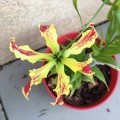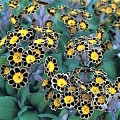A few of our neighbors love growing this plant with the huge, showy white flowers. It has more nicknames than most commonly grown ornamentals, including jimsonweed, devil’s trumpet, devil’s snare, devil’s weed, devil’s cucumber, Jamestown weed, stinkweed, locoweed, pricklyburr, hell’s bells, and Thornapple. But why are there so many references to the devil? Because all parts of Datura plants contain dangerous levels of the tropane alkaloids atropine, hyoscyamine, and scopolamine, which are classified as deliriants. The risk of a fatal overdose is high among uninformed users, and many hospitalizations occur amongst recreational users who ingest the plant—by eating it or smoking it–for its psychoactive effects.
Datura intoxication typically produces delirium (rather than hallucinations), hyperthermia, tachycardia, bizarre behavior, and severe dilation of the pupils with resultant painful photophobia that can last several days. Pronounced amnesia is another commonly reported effect, and if you forget that this plant can cause death, you’re in big trouble.
I suggest that you do not use Datura as a garden plant. If you love large white flowers try planting mock orange (Philadelphus spp.), or giant white moonflower (Ipomoea spp.)
The Deadly Datura











